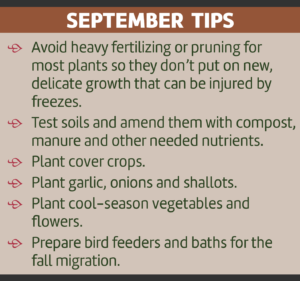
Now and on through the fall is the ideal time here in Alabama (and elsewhere) to add all kinds of plants — from ornamentals to edibles, many of which may be on sale this time of year — to our garden beds and landscapes. It’s an especially good time to plant perennials (any plant species that lives longer than two years) with an eye on the coming gardening year.
Fall is ideal because its cooler air temperatures reduce heat stress on plants (and gardeners) and lower pest and weed pressures. Meanwhile, soils tend to remain warm, and rainfall is often abundant in the fall, both of which help plants establish deeper, stronger root systems before winter arrives. This combination of conditions gives fall-planted plants a leg up on those planted in the winter or spring. Another plus: you’ll have plenty to do this spring so planting now frees up time for next year’s gardening chores.
If you’re finding it difficult to even entertain the idea of fall planting when summer is not yet done, use this month to plan for October through December when the weather should be perfect for gardening work.
Start by identifying places in the yard and garden that need new plants, then figure out what plants you want to use in those places. Get a soil test for those sites and add amendments as needed. You may need to order plants, especially bulbs and seeds, so make that a priority this month, too.
While you can plant lots and lots of things in the fall, including cool season annuals and bi-annuals and sod, here are a few suggestions of tried-and-true perennials to get you started.
Spring bulbs:
Daffodils, hyacinth, crocus, tulips and other bulbs are almost always one of the first signs of spring and most tolerate any well-drained soil type (they will rot if the ground is too wet). They can be used in flower beds, open meadows and lawns, under deciduous trees and shrubs and in containers.
Herbaceous perennials:

Many flowering perennials do spectacularly well when planted in the fall, some of which may even put on a brief show of flowers soon after planting and pop out in full bloom in the spring. The list is extensive but among the best to plant in the fall are asters, hellebores, peonies and phlox. Fall is also a great time to divide existing perennials, including irises to replant them elsewhere in the yard or give to fellow gardeners.
Wildflowers:
Though technically these are herbaceous perennials category, I believe wildflowers — especially native species — deserve special consideration for fall planting. Most can be planted from seed sprinkled onto loosened soil (no trowel or shovel needed, though a rake will be useful) then pressed lightly into the soil using your own two feet or a roller. They require little to no additional water or fertilizer and come back year after year. Use a seed mixture of different species — coneflowers, coreopsis, daisies, bee balm, salvias and many others — and you’ll have something flowering almost all year long. The local birds, bees and other wildlife and insects will thank you, too.
Woody perennials:
Most trees, shrubs and vines benefit from fall planting, including winter and early spring bloomers (camellias, azaleas, rhododendrons, forsythias, dogwoods, redbuds and silverbells, for example) and late spring/summer beauties (hydrangeas, magnolias, gardenias and crepe myrtles to name a few).
Ball-and-burlap or container-grown plants are best to plant in the fall, and bare-root plants in the spring; it’s always worth taking the time to dig and prepare the holes properly. (See recommendations for each plant.) It’s also important to water them well after planting and keep watering them through the drier winter weather.
These are just a few of many things to plant this fall, so take a little break from your summer work and explore the possibilities. You’ll be glad you did.
Katie Jackson is a freelance writer and editor based in Opelika, Alabama. Contact her at [email protected].




